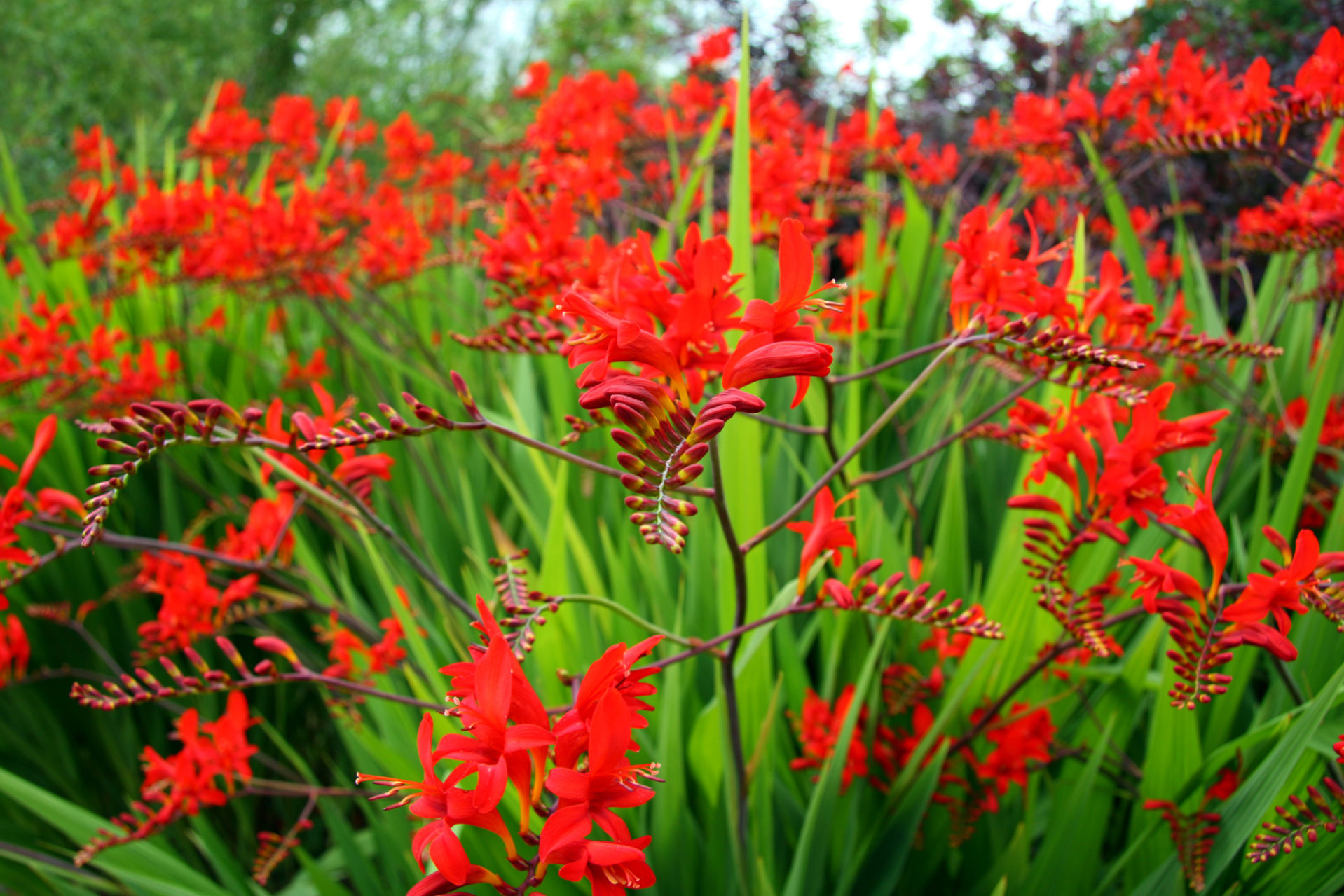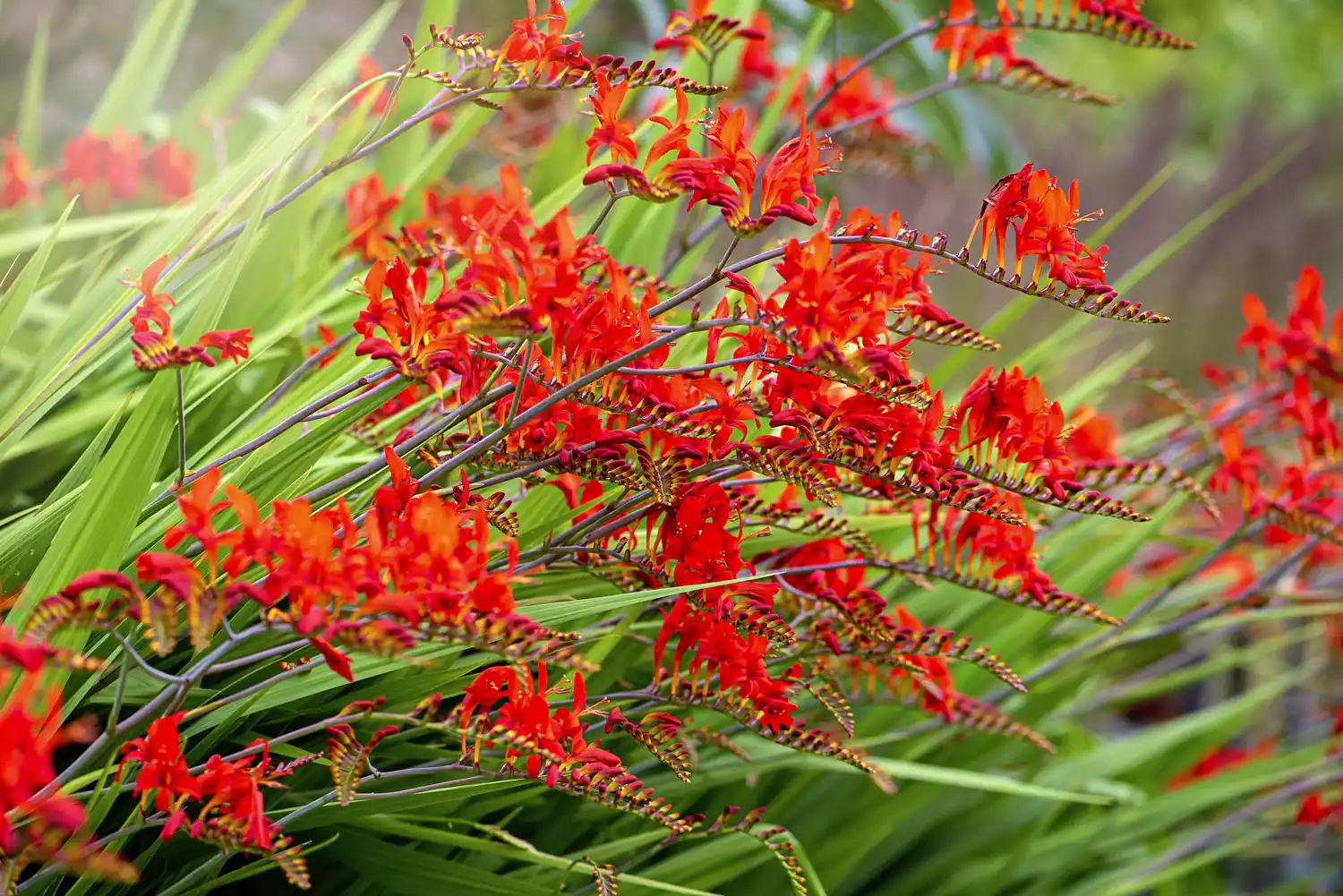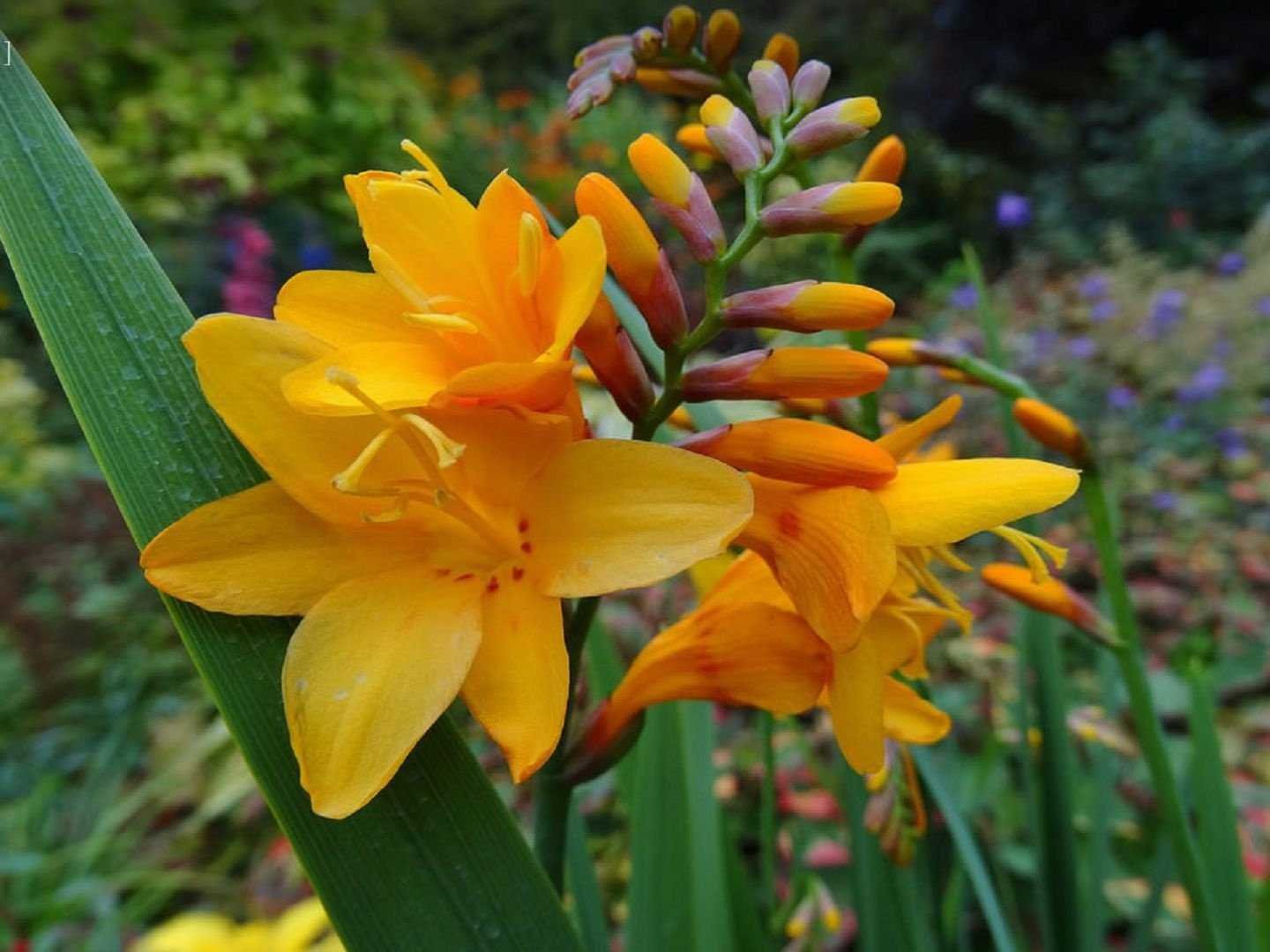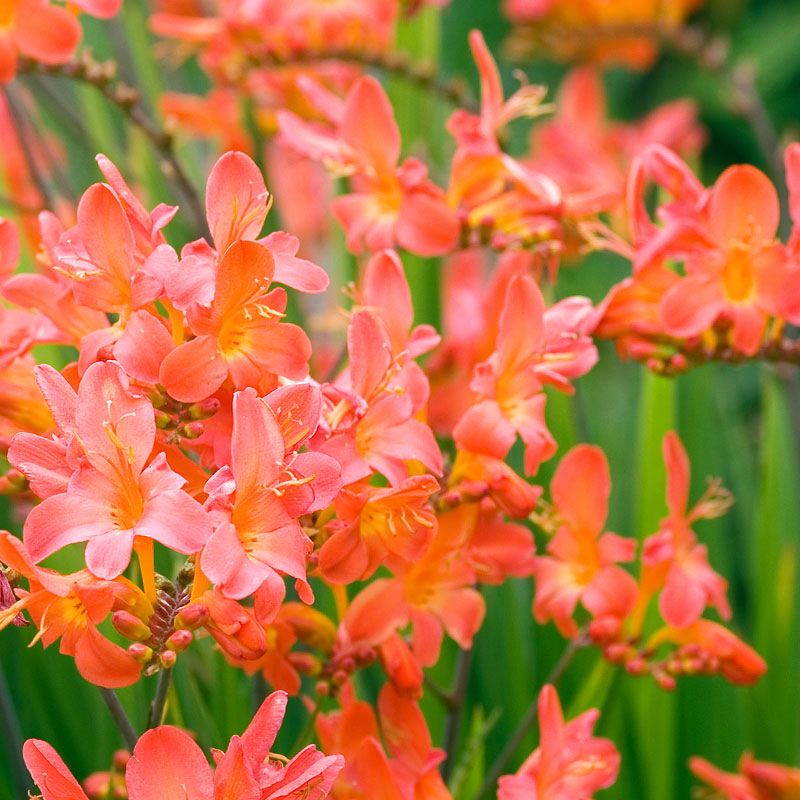You don’t need to travel to South Africa to enjoy one of its finest flowers. Crocosmia, a member of the lily family, grows in the South and is often a pass-along variety that grows in cottage gardens and old homesites. Known to many as “montbretia,” this flower blooms in clusters during the hottest summer days, like fireworks on the Fourth of July.

Cousin to the gladiolus, the foliage is similar in its upright, sword-shaped leaves. This plant grows three to four feet tall from bulb-like corms. In summer, sprays of tubular red, orange, or yellow blooms appear on arching wands suitable for cutting. Blossoms attract hummingbirds and butterflies. ‘Lucifer’ is the most popular selection because of its flame-red flowers. This flower grows from creeping stolons, so it can multiply quickly if not cut. They are only slightly invasive due to their fast proliferation rate. They are known to be slightly toxic when ingested by pets, so it’s best to keep your furry friends away from this plant and its corms.

Plant Attributes
- Common Name: Coppertips, Falling Stars, Valentine Flower, Montbretia
- Botanical Name: Crocosmia aurea
- Family: Iridaceae
- Plant Type: Perennial, Corm
- Mature Size: 2-4 ft. tall, 1-2 ft. wide
- Sun Exposure: Full
- Soil Type: Moist but Well-drained, Humus-Rich
- Soil pH: Neutral (7.0)
- Bloom Time: Summer
- Flower Color: Red, Orange, Yellow
- Hardiness Zones: Zones 6-9 (USDA)
- Native Area: Africa
Crocosmia Care
Growing crocosmia is easy. Plant the corms two inches deep and three inches apart into fertile, well-drained soil in spring. Full to partial sun is fine. ‘Lucifer’ is winter-hardy to USDA Zone 5. Other selections grow best in Zone 6, but they’ll grow as far south as Zone 9. Happy corms multiply quickly, so don’t be surprised to find many more crocosmias after a year or two than you planted in the ground. They’re only slightly invasive because you might wind up with more than you want. To stop the spread of this plant, pass some along to a friend.
Light
Crocosmia grows best in an area that receives at least six to eight hours of direct sunlight daily. In hot climates, some afternoon shade is acceptable. Because of its creeping nature, you can tell if your plant is trying to reach more sunlight, which would require you to replant Crocosmia in a more suitable location.

Soil
Well-drained soil is the most important factor when growing Crocosmia. Depending on your soil environment, amend heavy clay soils with organic material, such as sand and peat moss, to create loose and aerated soil. Crocosmia also grows in containers that need soil rich with nutrients.
Water
Crocosmia needs moist but well-drained soil. During the growing season, water plants once weekly so the topsoil is consistently moist. Don’t water-log the plant.
Temperature and Humidity
Crocosmias grow best in drier climates with mild temperatures, so if you live in an area that sees frequent frost and low temperatures, plant these flowers in containers and move them inside for the fall and winter. Crocosmias also tolerate heat and humid climates but ensure the soil never completely dries out. In these areas, planting in areas with afternoon shade can help protect this flower.
Fertilizer
After planting Crocosmia, there is not a lot of care required. Using fertilizer can encourage foliage overgrowth, but this will replace flower blooms, which is not ideal and, therefore, not recommended.
Types of Crocosmia
- ‘Lucifer’: The most popular Crocosmia variety, this flower blooms in a firey red, attracting hummingbirds and other pollinators.
- ‘Golden Fleece’: This Crocosmia variety blooms in its signature star-shaped spikes in a golden yellow. It’s considered a frost-hardy perennial.
- ‘Dixter Flame’: Considerably smaller than ‘Lucifer,’ this red-orange flower is best viewed from above as the flower stems grow horizontally.
Pruning
Crocosmia does not need pruning, but deadheading flowers can encourage new growth. If necessary, prune leaves at the end of the growing season to manage size and spread. Crocosmia leaves can remain on the branches after the growing season and blooming finishes because this is what supplies the plant with nutrients for the following year’s growth.
Propagating Crocosmia
Crocosmias quickly spread because of their natural crawling tendencies, so propagation is only necessary if you want to give these flowers as pass-along plants or to start growing them in a new area. The best way to do this is by dividing the corms. Here is how to propagate Crocosmia through dividing:
- In the spring, gently dig around the corms and lift the clump out of the soil.
- If your Crocosmia has been growing for a few years, new corms might appear to grow on top of older corms in a “conjoined string” formation. Gently pull corms apart.
- Choose the top two corms from the “conjoined string” and plant in a well-draining soil at least six to eight inches away from existing Crocosmia.
- Mulch with peat moss or other organic compost to encourage new growth.

How to Grow Crocosmia From Seed
It is best to start with store-bought seeds to grow Crocosmia and plant them indoors to provide space to grow corms. You can also harvest seeds from existing plants from the capsules that form in the fall.
- If harvesting seeds, gently cut seeds with a sharp knife and soak them in water. Save the seeds in a paper bag and store them in a cool, dark location until the spring.
- In the spring, use a seed-starting tray and plant one-fourth an inch deep in potting soil rich with nutrients.
- Place the tray in a warm location and water. Make sure to keep the soil moist but well-drained.
- After the chance of frost passes, plant the new growth in its final location at least six to eight inches away from existing plants. Plant a few inches (three to five) deep and continue watering.
Overwintering
If your environment experiences cold winters, it is best to plant Crocosmia in containers so you can move them indoors for the winter. A second option is to dig up the corm and store it in a cool, dark area for its dormant season. Adding a thick, organic mulch can help protect Crocosmia over the winter. Most Crocosmias are cold-hardy in Zones 6-9, but this depends on the variety.
Common Pests & Plant Diseases
Crocosmias are relatively pest-resistant and also rabbit resistant. Spider mite infestations might harm Crocosmias if planted in soil that does not drain properly, but neem oil can treat this problem—Gently misting plants also helps rid this infestation.
How to Get Crocosmia to Bloom
Crocosmias bloom from mid-summer until mid-fall depending on the variety. This extremely showy flower blooms for one to two months. Deadheading spent flowers will encourage new growth—Remove the stem until it meets the leaves. If you experience a year without blooms, it might be that you removed the previous year’s foliage, which helps promote growth for the following year’s flowers. Additionally, fertilizer is generally not recommended for growing Crocosmia because it redirects growth to the greenery at the expense of the flowers.
Common Problems With Crocosmia
Leaves Turning Brown/Yellow
Gladiolus rust is a fungus that sometimes infects Crocosmia. If leaves start showing spores with brownish-black or brownish-yellow markings, this signifies that gladiolus rust is present. This fungus also affects the corms and can appear on flowers. A copper-based fungicide can help treat this disease.
Plant Leaves Falling Off
When planted in wet or poorly drained soil, bulb rot is a bacterial disease that can spread throughout Crocosmias quickly. If you do not see flowers emerging in the summer, or yellow or stunted leaf growth, rot might have set in. Unfortunately, since this disease affects the corms, they need to be discarded as they are likely soft, rotten, and unable to produce new growth.





